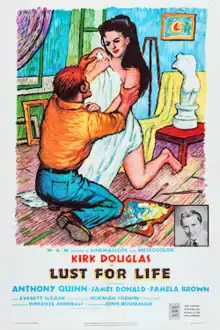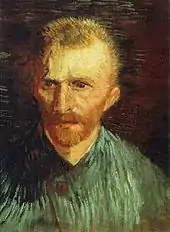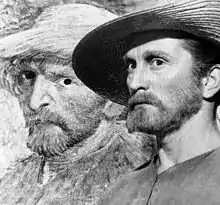Lust for Life (1956 film)
Lust for Life is a 1956 American biographical film about the life of the Dutch painter Vincent van Gogh, based on the 1934 novel of the same title by Irving Stone which was adapted for the screen by Norman Corwin.
| Lust for Life | |
|---|---|
 Theatrical release poster | |
| Directed by | Vincente Minnelli George Cukor (uncredited – supervised one retake) |
| Produced by | John Houseman |
| Written by | Norman Corwin |
| Based on | Lust for Life by Irving Stone |
| Starring | Kirk Douglas Anthony Quinn James Donald |
| Music by | Miklós Rózsa |
| Cinematography | Russell Harlan F. A. Young |
| Edited by | Adrienne Fazan |
| Distributed by | Metro-Goldwyn-Mayer |
Release date | September 17, 1956 |
Running time | 122 minutes |
| Country | United States |
| Language | English |
| Budget | $3,227,000[1] |
| Box office | $2,695,000 (rentals)[1][2] |
It was directed by Vincente Minnelli and produced by John Houseman. The film stars Kirk Douglas as Van Gogh, James Donald as his brother Theo, with Pamela Brown, Everett Sloane, and Anthony Quinn. Douglas won the Golden Globe Award for Best Actor – Motion Picture Drama for his performance, while Quinn won the Academy Award for Best Supporting Actor.[3]
Plot

Vincent has trained to be a minister, like his father, but the church authorities find him unsuitable. He pleads with them to be allowed some position and they place him in a very poor mining community. Here he becomes deeply absorbed in the daily poverty and begins sketching daily life.
The religious leaders do not like his approach, and they frown on his social activism and care for the poor. He returns home to his father's house. Here a woman he obsessively loves (his cousin) rejects Van Gogh because of his inability to support himself financially. The infatuated Vincent follows her to her family home, where he holds his hand over a candle flame to prove his devotion, only to learn that she has said she is disgusted by him and doesn't want to see him again.
He takes to drawing. His cousin Mauve gives him paint and artist materials and encourages him to paint. His brother, Theo van Gogh, provides financial and moral support. He takes up with a prostitute who eventually also leaves because he is too poor. His passion then turns fully to painting, which he pursues while agonizing that his vision exceeds his ability to execute.
After his father's death, he goes to Paris with Theo, where he discovers impressionists. Theo cannot bear living with him and Vincent leaves for sunny Arles. Paul Gauguin (whom he met in Paris) joins him there, and for a while life is good, but Vincent is too obsessive even for Gauguin's tastes and they argue, after which Vincent cuts off his own ear. Vincent begins experiencing hallucinations and seizures and voluntarily commits himself to a mental institution. He signs himself out, and with Theo's help returns to a rural area to resume painting. Out painting cornfields he is frustrated by the crows and ultimately shoots himself in despair at never being able to put what he sees on canvas. He dies a few days later.[3]
Cast
- Kirk Douglas as Vincent van Gogh, struggling painter.
- Anthony Quinn as Paul Gauguin, painter and friend of Vincent's.
- James Donald as Theo van Gogh, Vincent's brother.
- Pamela Brown as Christine, Vincent's lover, based on Sien.
- Everett Sloane as Dr. Paul Gachet
- Henry Daniell as Theodorus van Gogh, father of Vincent and Theo.
- Madge Kennedy as Anna Cornelia van Gogh, mother of Vincent and Theo.
- Noel Purcell as Anton Mauve, established painter and cousin of Vincent and Theo.
- Niall MacGinnis as Roulin
- Jill Bennett as Willemien
- Lionel Jeffries as Dr. Peyron.
- Laurence Naismith as Dr. Bosman
- Eric Pohlmann as Colbert
- Jeanette Sterke as Kay (Cornelia "Kee" Vos-Stricker), cousin of Vincent and Theo.
- Toni Gerry as Johanna (Johanna van Gogh-Bonger)
Production

The film was based on the 1934 novel by Irving Stone and adapted by Norman Corwin. Vincente Minnelli directed the film, while John Houseman produced it. They worked with Douglas on the 1952 melodrama The Bad and the Beautiful, for which he was nominated for an Academy Award for Best Actor.
Principal photography started in August and ended in December 1955 and it was shot on location in France, Belgium and the Netherlands. George Cukor took Minnelli's place as director for the take of a scene. Two hundred enlarged colour photos were used representing Vincent’s completed canvases; these were in addition to copies that were executed by an American art teacher, Robert Parker. To prepare for his role as the troubled painter, Douglas practiced painting crows so that he could reasonably imitate van Gogh at work.[4] According to his wife Anne, Douglas was so into character that he returned to home in character. When asked if he would do such a thing again, Douglas responded that he wouldn't.
Reception
The film received mostly positive reviews from critics. The New York Times critic Bosley Crowther praised the film's conception, acting and color scheme, noting the design team "consciously made the flow of color and the interplay of compositions and hues the most forceful devices for conveying a motion picture comprehension of van Gogh."[5] Variety said, "This is a slow-moving picture whose only action is in the dialog itself. Basically a faithful portrait of Van Gogh, Lust for Life is nonetheless unexciting. It misses out in conveying the color and entertainment of the original Irving Stone novel."[6] Harrison's Reports wrote that the film had been given "an excellent production" and that "Kirk Douglas does outstanding work as Van Gogh, and Anthony Quinn is very good as Paul Gauguin, his friend."[7] John McCarten of The New Yorker wrote, "Even if the movie doesn't delve as deeply as it might into the mental processes that made van Gogh behave the way he did, it nevertheless, in the person of Kirk Douglas, confronts us with a character well worth our absorbed attention. Mr. Douglas, who, wearing red whiskers, bears a striking resemblance to van Gogh's self-portraits, succeeds most skillfully in arousing a conviction that he is, in truth, a painter beside himself to capture light and hold it forever on canvas."[8] Richard L. Coe of The Washington Post called the film "a remarkable achievement, combining a rich adventure in the art of color with a perceptive study of a creative personality. In this biography of Vincent Van Gogh, Kirk Douglas adds to his advantage of striking resemblance a performance of powerful sensitivity."[9] Edwin Schallert of the Los Angeles Times called the film a "remarkable and poignant study," and forecast that the artist's 'stellar portrayal' by Kirk Douglas "will be recognized for Academy honors."[10] The Monthly Film Bulletin printed a somewhat negative review, writing: "Although one feels that those responsible were determined to 'do right' by Van Gogh, this biographical tribute never rises above the level of the popular novel on which it is based ... Despite a remarkable physical resemblance, Kirk Douglas' performance remains essentially an American study in neuroticism; also, the presentation of the aesthetic controversy between Van Gogh (humane and intuitive) and Gauguin (intellectual and brusquely cynical) is both oversimplified and somewhat misleading."[11]
Box office
The world premiere was held on September 17, 1956 at the Plaza Theatre on East 58th Street in New York City as a benefit for the Metropolitan Museum of Art's student program.[12] It played there for a record 37 weeks, grossing $450,000.[13]
According to MGM records, the film earned rentals of $1,595,000 in the US and Canada and $1,100,000 elsewhere resulting in a loss of $2,072,000.[1]
Awards and nominations
- 29th Academy Awards nominations
- [14][15]
- Best Actor: Kirk Douglas
- Actor in a Supporting Role: Anthony Quinn (won)
- Best Writing (Screenplay--Adapted): Norman Corwin
- Best Art Direction (Color): Art Direction: Cedric Gibbons, Hans Peters, E. Preston Ames; Set Decoration: Edwin B. Willis, F. Keogh Gleason
- 14th Golden Globe Awards nominations
- Best Motion Picture – Drama
- Best Actor – Motion Picture Drama - Kirk Douglas (won)[16]
- Best Supporting Actor – Motion Picture - Anthony Quinn[17]
- Best Director - Vincente Minnelli[18]
Companion short film
MGM produced a short film, Van Gogh: Darkness Into Light, narrated by Dore Schary and showing the European locations used for the filming, to promote Lust for Life. In the film, a 75-year-old woman from Auvers-sur-Oise (not Jeanne Calment, who lived in Arles several hundred kilometers to the south), who claims to have known Van Gogh when she was a young girl, meets star Kirk Douglas, and comments on how much he looks like the painter. This short promotional film is shown on Turner Classic Movies occasionally. At the start and ending of the film, the creators list and thank a number of galleries, collectors and historians who allowed the works of Van Gogh to be photographed for the film.
See also
- List of American films of 1956
- Death of Vincent van Gogh
- Vincent (1987 documentary)
- Vincent & Theo (1990 biographical film about van Gogh that is often compared to Lust for Life)
- Loving Vincent (2017 film about van Gogh)
- At Eternity's Gate (2018 biographical film about van Gogh)
References
- The Eddie Mannix Ledger, Los Angeles: Margaret Herrick Library, Center for Motion Picture Study.
- Domestic take see "Top Grosses of 1957", Variety, 8 January 1958: 30
- "Lust for Life (1956) - Vincente Minnelli | Synopsis, Characteristics, Moods, Themes and Related | AllMovie". AllMovie. Retrieved 2018-01-09.
- Walker, John. (July 1990) Vincent van Gogh films: Of cypresses and sunflowers Archived 2016-03-03 at the Wayback Machine, Monthly Film Bulletin/artdesigncafe. Retrieved October 12, 2010.
- Crowther, Bosley (September 18, 1956). "Screen: Color-Full Life of van Gogh". The New York Times: 39.
- "Lust for Life". Variety: 6. September 5, 1956.
- "'Lust for Life' with Kirk Douglas". Harrison's Reports: 144. September 8, 1956.
- McCarten, John (September 29, 1956). "The Current Cinema". The New Yorker: 86.
- Coe, Richard L. (September 21, 1956). "'Lust for Life' Real Triumph". The Washington Post: 79.
- Schallert, Edwin (September 22, 1956). "'Lust for Life' Reveals Saga of Tortured Artist". Los Angeles Times: 8.
- "Lust for Life". The Monthly Film Bulletin. 24 (278): 29. March 1957.
- "Museum Lends van Gogh to Premiere of Film on Artist". The New York Times: 23. September 15, 1956.
- "'Lust's' $450,000 Plaza, N.Y. Gross". Variety. June 19, 1957. p. 3. Retrieved April 19, 2019.
- "The 29th Academy Awards (1956) Nominees and Winners". oscars.org. Retrieved 2013-02-17.
- "NY Times: Lust for Life". NY Times. Retrieved 2008-12-22.
- "Best Performance by an Actor in a Leading Role" "Archived copy". Archived from the original on 2012-03-09. Retrieved 2013-04-18.CS1 maint: archived copy as title (link)
- "Best Performance by an Actor in a Supporting Role in a Motion Picture" "Archived copy". Archived from the original on 2012-03-09. Retrieved 2013-04-18.CS1 maint: archived copy as title (link)
- "Best Director-Motion Picture" "Archived copy". Archived from the original on 2012-03-09. Retrieved 2013-04-18.CS1 maint: archived copy as title (link)
External links
- Lust for Life at IMDb
- Lust for Life at the TCM Movie Database
- Lust for Life at AllMovie
- Lust for Life at Rotten Tomatoes

- Van Gogh: Darkness Into Light at IMDb, a short companion film